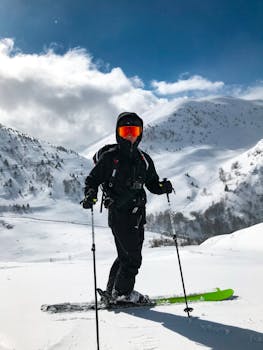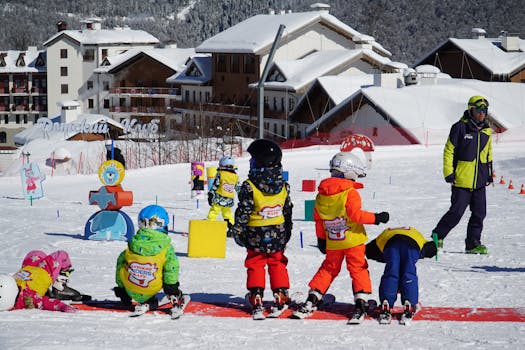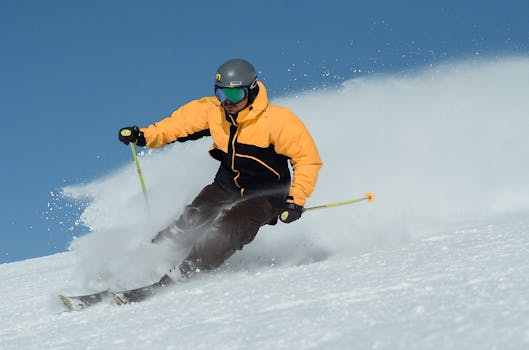Telluride Skiing: Complete Guide for All Skill Levels (2025)
Everything you need to ski Telluride successfully: ability-specific strategies, altitude management, equipment recommendations, lesson options, safety tips, and insider techniques.

Telluride Skiing: Complete Guide for All Skill Levels (2025)
Skiing Telluride successfully requires more than just showing up with equipment and a lift ticket. The combination of high altitude starting at 8,750 feet and reaching above 13,000, challenging terrain that comprises 41% advanced/expert runs, variable conditions across different mountain zones, and the unique two-base-area layout demands thoughtful approach regardless of your ability level. First-time visitors who treat Telluride like any other resort often struggle unnecessarily, while those who understand its specific characteristics have exceptional experiences.
This comprehensive guide provides ability-specific strategies for maximizing your Telluride skiing, from beginners taking first runs to experts tackling Palmyra Peak’s extreme chutes. We’ll cover altitude management techniques that prevent ruined vacation days, equipment selection appropriate for Colorado conditions, lesson programs that accelerate learning, terrain progression that builds confidence safely, and insider tips that locals use to find the best snow and avoid crowds.
 Photo by Melvin Wahlin via Pexels
Photo by Melvin Wahlin via Pexels
For detailed resort information including lift system, terrain breakdown, and operational details, see our complete Telluride ski resort guide. To plan your visit timing around optimal conditions, check our ski season guide. For slope-side accommodations, review our best hotels in Telluride.
Note: Snow conditions, terrain access, and operational details vary throughout the season. Always check current conditions, your equipment, and your physical capability before attempting challenging terrain.
Altitude Management: The Critical First Step
Telluride’s base elevations of 8,750 feet downtown and 9,500 feet at Mountain Village challenge every visitor regardless of fitness level. The summit reaches 13,150 feet, where oxygen levels sit at roughly 60% of sea level density. This dramatic altitude affects everyone differently but impacts everyone to some degree. Failing to address altitude concerns ruins more Telluride vacations than any other single factor.
Arrive at least one full day before skiing to begin acclimatization. Your first afternoon and evening should involve light activity, exploring downtown shops and restaurants, and avoiding alcohol. Sleep proves difficult at altitude initially—expect to wake multiple times and feel less rested than normal. This improves over 2-3 nights as your body adjusts.
Hydration matters far more at altitude than at sea level. Aim for twice your normal water intake starting the day you arrive and continuing throughout your trip. The dry mountain air and increased respiration rapidly dehydrate you, causing headaches, fatigue, and impaired judgment before you recognize the symptoms. Carry water bottles while skiing and drink constantly even when you don’t feel thirsty.
Limit alcohol consumption, especially the first 2-3 days. Alcohol dehydrates you and impairs your body’s altitude adjustment mechanisms. That single après-ski beer hits like three at sea level, and the morning-after effects prove significantly worse at 9,000+ feet. Many visitors learn this lesson the hard way after night-one celebrations result in day-two suffering.
Watch for warning signs of altitude sickness: persistent headache, nausea, unusual fatigue, shortness of breath beyond normal exertion, and difficulty sleeping. Mild symptoms affect most visitors and resolve with rest, hydration, and time. Severe symptoms—confusion, difficulty walking, extreme shortness of breath—require immediate descent and medical attention. Don’t push through severe symptoms hoping they’ll improve.
First-run strategy matters significantly at altitude. Start with easy terrain regardless of your ability level to assess how your body performs. That black run you ski confidently at Tahoe may overwhelm you at Telluride purely due to altitude effects. Give yourself permission to ski below your normal level until you understand how altitude affects your specific performance.
For Beginners: Starting Your Skiing Journey
The Meadows area at Mountain Village provides Telluride’s dedicated learning zone, with wide-open spaces, gentle sustained pitches, and isolation from faster traffic. Magic carpets eliminate the intimidation and difficulty of loading chairlifts, allowing complete beginners to focus entirely on skiing fundamentals. The area’s size enables progression from first turns to confident parallel skiing without leaving the learning zone.
 Photo by Irina Balashova via Pexels
Photo by Irina Balashova via Pexels
Invest in lessons rather than having friends or family teach you. Professional instructors from Telluride Ski & Snowboard School understand learning progression, communicate technical concepts effectively, and correct bad habits before they become ingrained. Group lessons cost $180-220 for full-day packages including rental equipment, while private lessons start around $400 for two hours. The investment pays dividends through faster progression, better technique, and fewer frustrating falls.
Three-day lesson packages deliver better results than single days. Day one covers basics and often feels overwhelming with new information and physical demands. Day two reinforces fundamentals and builds confidence. Day three enables real skiing rather than just survival, letting you enjoy the experience rather than fighting equipment and terrain. Many beginners take one lesson then struggle alone for days—reverse this pattern for better outcomes.
Rent quality equipment rather than budget packages. Properly fitted boots make enormous difference in control and comfort. Demo or premium rental packages include better skis that turn more easily and forgive technique errors. The $20-30 daily upcharge over budget rentals eliminates significant frustration and accelerates learning. Most rental shops including Telluride Sports and Bootdoctors provide excellent fitting services and quality equipment.
Dress in layers anticipating variable conditions and exertion levels. Beginners typically run hot from nervous energy and constant falling, requiring less insulation than assumed. Start with base layer, light insulating layer, and waterproof shell. Stash extra layers in a backpack or locker. Quality ski socks (one pair, not two or three) prevent blisters. Waterproof gloves matter more than expensive ones—wet hands cause premature day endings.
Set realistic expectations for progression speed. Most people require 3-5 full days to ski green runs confidently and comfortably. Athleticism and prior board sports experience accelerate this timeline, but even elite athletes in other sports need time developing skiing-specific balance, edge control, and technique. Accept falls as learning tools rather than failures, and celebrate small progressions like your first successful turn or chairlift loading.
For Intermediates: Progressing Your Skills
Intermediates arriving at Telluride often face the “intermediate plateau”—comfortable on groomed blues but intimidated by steeper terrain, moguls, and off-piste skiing. Telluride’s terrain distribution (36% intermediate) provides excellent variety for building skills, but maximizing your progression requires strategic terrain selection and technique focus rather than simply lapping the same comfortable runs repeatedly.
See Forever and Misty Maiden serve as your daily warm-up runs and confidence builders. These perfectly groomed cruisers from near-summit areas to valley floor provide sustained skiing where you can work on carving technique, speed control, and rhythm without worrying about obstacles or steep surprises. Ski these early when grooming is fresh to establish good movement patterns before fatigue sets in.
Progress to intermediate terrain with variations—rolling pitches, moderate bumps, and gentle tree spacing. Runs like Kant-Mak-M and the intermediate options off Chair 10 introduce challenges while maintaining intermediate-appropriate consequences. These runs teach you to adjust turn shape and speed for varying terrain rather than just linking identical turns down uniform slopes.
 Photo by Matias Mango via Pexels
Photo by Matias Mango via Pexels
Sample easier black runs late in your trip after building confidence and mountain familiarity. Not all black runs share equal difficulty—some represent entry-level advanced terrain while others challenge experts. Research specific runs using trail maps and ask ski school instructors or patrollers which blacks provide the gentlest introduction to advanced skiing. Attempting one short steep section followed by easier terrain builds confidence more effectively than committing to long sustained difficult runs.
Consider intermediate lesson packages focusing on specific skills. Clinics for moguls, powder, steeps, and trees accelerate progression more efficiently than figuring these techniques independently. Two-hour private lessons enable intensive focus on your specific limiting factors. Many intermediates ski for years without lessons, improving slowly or not at all. Targeted instruction often produces breakthrough improvements in single sessions.
Explore the Front Side tree skiing through wider-spaced aspens on runs where you can see through the trees. This introduces off-piste skiing in a forgiving environment without the commitment and consequence of tight trees or steep faces. Tree skiing at intermediate level teaches line selection, rhythm adjustment, and powder technique without requiring advanced skills. Many intermediate skiers avoid trees entirely, missing some of Telluride’s most enjoyable terrain.
Weather your conditions—the best learning happens on variable days rather than perfect bluebird mornings. Flat light, light snow, and wind teach you to ski by feel rather than sight, developing more complete skills. Many intermediates only ski perfect conditions then struggle when weather deteriorates. Deliberately skiing in less-than-ideal conditions (avoiding dangerous conditions but accepting uncomfortable ones) builds versatility and confidence.
For Advanced Skiers: Tackling Challenging Terrain
Advanced skiers find Telluride’s terrain distribution ideal, with 41% of runs rated black or double-black. However, Telluride’s advanced terrain demands respect—steep sustained pitches, consequential fall lines, high altitude affecting performance, and exposed areas with limited bailout options. Success at this level requires technical proficiency, fitness, good judgment, and proper warm-up progression.
Begin every day with groomed intermediate runs regardless of your eagerness to hit challenging terrain. Cold muscles, altitude effects, and equipment that hasn’t flexed yet all compromise performance on your first runs. Two or three warm-up runs at moderate pace and intensity prepare your body and mind for demanding skiing. Jumping straight to double-blacks from the parking lot sets up potential injury or poor performance.
The Plunge area provides excellent advanced terrain progression. Multiple runs ranging from challenging blues to legitimate double-blacks allow you to assess conditions, snow quality, and your performance level before committing to Gold Hill’s exposed bowls. The short lift ride enables quick laps to dial in technique or chase powder stashes. Most locals start here rather than immediately heading to the summit regardless of ability level.
Gold Hill demands different approach than Front Side skiing. The scale, exposure, and sustained steepness require managing fear and maintaining technique under pressure. Scout lines from the chairlift to identify your intended route, escape options, and obstacle locations. The vast terrain can intimidate even strong skiers—breaking it into smaller sections mentally makes it more approachable.
Respect Black Iron Bowl’s reputation and requirements. While lacking Palmyra’s hike access, the bowl presents legitimate expert skiing with consequences. The sustained pitch, limited traverse options once committed, and altitude all challenge your capabilities. Ski it later in your trip after acclimatizing to altitude and familiarizing yourself with Telluride’s general terrain character.
Tree skiing at advanced level opens huge terrain options during storms and flat light. The Front Side offers varied tree density and pitch, allowing you to choose appropriate challenges. Trees demand precise turns, constant line adjustments, and commitment to your chosen path. Start with lower-angle tree runs and wider spacing before tackling steep tight trees. The powder preservation in trees extends good skiing days beyond when open terrain gets tracked out.
Expert Terrain Strategies
Palmyra Peak’s hike-to chutes represent Telluride’s most extreme in-bounds terrain, requiring 20-30 minute bootpack from Chair 12 summit to the 13,320-foot peak. Multiple chutes dropping from the summit provide steep sustained skiing at 40-50 degrees with cliff exposure and commitment. This terrain demands expert-level skiing ability, high-altitude fitness, avalanche awareness despite in-bounds status, and good judgment about conditions and personal capability.
Start your Palmyra attempt early morning when snow remains stable from overnight freezing. Spring corn snow conditions (late March through closing) often provide the best Palmyra skiing—softened surface without powder’s avalanche concerns. Check the daily snow report for area status before hiking, as Palmyra closes frequently for wind, avalanche hazard, or poor visibility.
 Photo by Kirill Lazarev via Pexels
Photo by Kirill Lazarev via Pexels
The bootpack itself challenges fitness at 13,000+ feet. Pace yourself to avoid exhaustion before skiing. Many skiers hurry up only to lack energy and oxygen for controlled descent. Carry water and stop to catch your breath when needed. The summit views rival anywhere in North America—take time to appreciate them rather than rushing straight into skiing.
Line selection on Palmyra makes enormous difference between manageable and disastrous descent. Scout multiple routes and identify the one matching your ability and current conditions. Committing to a line beyond your capability on Palmyra creates genuinely dangerous situations. No shame exists in hiking up, assessing conditions, and choosing an easier option or even skiing alternate terrain.
Revelation Bowl provides expert terrain without Palmyra’s hike requirement. The bowl’s multiple entrances, varied aspects, and significant vertical spread the crowds and offer different conditions depending on wind and sun exposure. The area operates conditionally—closed during and after storms for avalanche control—so check status throughout the day as it may open midday after patrol work completes.
Expert tree skiing through tight aspens and evergreens demands precise technique and complete commitment. The tightest tree zones allow minimal turn radius and no hesitation. Scan ahead constantly rather than looking at your ski tips, trust your edges and technique, and accept that you’ll occasionally make contact with branches or tree wells. Expert tree skiing represents some of Telluride’s best terrain during storms when visibility elsewhere becomes dangerous.
Equipment and Gear Recommendations
Rent or bring skis appropriate for mixed conditions rather than specialized powder or ice skis. Telluride’s typical conditions include groomed runs, cut-up powder from tracked snow, variable wind-affected snow, and occasional ice patches at high elevations. All-mountain skis in the 85-95mm waist width handle this variety competently. Powder-specific skis with 100+ mm waists excel on deep days but struggle on groomed runs and variable snow.
Demo programs at rental shops including Telluride Sports, Bootdoctors, and Jagged Edge allow testing different ski models daily. This helps you find equipment matching your skiing style and typical Telluride conditions rather than guessing. Premium demo packages cost $60-80 daily but include highest-end equipment and unlimited swapping.
 Photo by Pixabay via Pexels
Photo by Pixabay via Pexels
Boot fit matters more than ski selection for control and comfort. Properly fitted boots should feel snug everywhere without specific pressure points, allow full ankle flex, and eliminate heel lift. Many skiers tolerate poor-fitting boots for years without realizing the performance compromise. Expert boot fitting services at local shops dramatically improve skiing through proper equipment fit. Budget 45-60 minutes for quality fitting rather than grabbing boots off shelves.
Layer clothing for variable conditions throughout the day. Morning temperatures at summit elevations frequently sit below zero even when Mountain Village base temps reach 20-30 degrees. Sun exposure, wind, and physical exertion create 30-40 degree temperature ranges during single ski days. Base layer, insulating layer, shell, and packable puffy enable appropriate adjustment as conditions change.
Carry backpacks with water, snacks, extra layers, and basic first aid items on advanced terrain days. Gold Hill and Palmyra’s extended runs and possible weather changes make self-sufficiency important. Small hydration packs or ski backpacks carry essentials without hindering skiing. Most intermediate and below terrain requires less gear due to frequent base-area returns.
Goggles with interchangeable lenses or photochromic technology handle Telluride’s variable light conditions. Bright sun on open slopes transitions quickly to flat light in trees or during storms. Having appropriate lens options prevents dangerous skiing in poor visibility or painful squinting in bright conditions. Many accidents occur when skiers push through marginal visibility rather than changing lenses or calling it a day.
Lift Strategy and Mountain Navigation
Upload via the gondola from downtown or Village Express from Mountain Village base. Most visitors stay in Mountain Village due to ski-in/ski-out convenience, but many downtown visitors arrive at Mountain Village base before uploading further. The two access points merge at mid-mountain regardless of starting location.
Chair 10 (Apex) provides the most efficient access to varied terrain with shortest wait times. This lift opens diverse blue and black options without forcing you through beginner areas or committing to summit terrain. Many experienced skiers lap Chair 10 extensively, only occasionally visiting other zones. Understanding this lift’s terrain access accelerates mountain familiarity.
Scout new terrain from chairlifts before skiing it. The ride up provides perfect vantage for identifying pitch, snow conditions, line options, and bailout routes. Many skiers ski terrain blindly then encounter unexpected challenges mid-run. Taking time to observe from the chair reduces surprises and improves line selection.
Download via gondola for lunch in downtown restaurants rather than eating expensive mediocre resort food. The 13-minute gondola ride down plus 13-minute return adds 30 minutes to lunch but saves $20-40 per person while providing better food and authentic downtown atmosphere. Many visitors never discover this option, assuming they’re trapped in Mountain Village for the day.
Safety Considerations
Stay within your ability level regardless of peer pressure or ego. Telluride’s challenging terrain and altitude create legitimate risks when people attempt runs beyond their capability. Most ski patrol evacuations involve intermediate skiers attempting advanced terrain rather than experts pushing limits. Assess terrain honestly against your actual ability, not your aspirational ability.
Ski with partners and maintain visual contact when possible, especially in advanced terrain, tree skiing, or poor visibility conditions. Telluride’s vast terrain and limited crowds mean you may not see other skiers for extended periods. Partner skiing ensures someone knows your location and can respond to problems.
Understand how to respond to altitude-related problems during skiing. Persistent dizziness, severe shortness of breath, or confusion require immediate descent to lower elevations and cessation of exertion. Don’t continue skiing hoping symptoms improve—they often worsen with continued altitude exposure and exertion.
Check weather forecasts and current conditions before committing to long exposed runs or hike-to terrain. Mountain weather changes rapidly, and getting caught in whiteout conditions on Gold Hill or Palmyra creates genuinely dangerous situations. When in doubt, ski more protected terrain and save exposed areas for better weather.
Making the Most of Your Telluride Skiing
Telluride rewards skiers who approach it thoughtfully, respecting the altitude, terrain, and conditions while taking time to learn the mountain’s specific characteristics. Whether spending three days or three weeks here, applying the ability-appropriate strategies outlined above dramatically improves your experience beyond simply showing up and skiing randomly.
For complete resort information including lift operations and detailed terrain breakdown, see our Telluride ski resort guide. To plan optimal visit timing, review our ski season guide. For slope-side accommodations enabling maximum ski time, check our best hotels in Telluride or search all places to stay near the resort.
Find Your Perfect Place to Stay
Browse our curated selection of ski-in/ski-out lodging, luxury resorts, and budget-friendly options.
Browse Places to StayRelated Articles

15 Best Hotels in Telluride: Top Places to Stay (2025)
The 15 best hotels in Telluride for 2025: luxury ski-in/ski-out properties, boutique downtown hotels, and budget-friendly options. Find your perfect mountain accommodation.

Telluride Ski Resort: Complete Guide (2025)
Everything you need to know about Telluride Ski Resort: terrain breakdown, lift system, best runs, ticket prices, expert tips, and how it compares to other Colorado resorts.

Telluride Ski Season: When to Visit & What to Expect (2025)
Everything about Telluride's ski season: opening and closing dates, monthly conditions, crowd patterns, pricing, snow totals, and the best times to visit for powder, value, or avoiding crowds.
